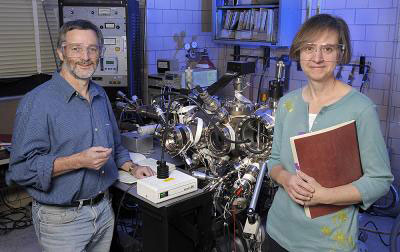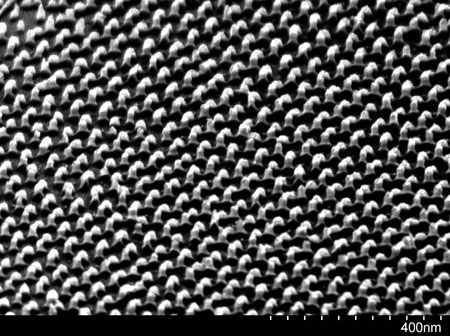CMU's Jeffrey O. Hollinger, director of the center, and Professor Krzysztof Matyjaszewski have received a three-year, $2.9 million U.S. Department of Defense research grant to develop a therapy that would aid amputees, specifically wounded soldiers.
Nov 4th, 2010
Read more
San Francisco State University (SF State) is the latest university to receive the Charles Babbage Grant from Synopsys. Through the grant, the School of Engineering received licenses of Synopsys' comprehensive electronic design automation (EDA) software and intellectual property, along with curriculum support and professor training. The grant also enabled the creation of a new Nanoelectronics and Computing Research Laboratory (NeCRL) by providing a new server and compute hardware for students.
Nov 4th, 2010
Read more
A $16-million, five-year grant by the National Cancer Institute's nanomedicine initiative blends the expertise of five research institutions to focus an array of innovative nanotechnologies on improving the outcome of patients with ovarian or pancreatic cancers.
Nov 4th, 2010
Read more
Nanoparticles could help smuggle drugs into the gut, according to a study published this month.
Nov 4th, 2010
Read more
 Researchers at RIKEN have successfully developed a revolutionary new polymer film that changes shape upon irradiation with UV and visible light. The film is the largest-ever example of a material whose molecular elements are ordered in three dimensions on a macroscopic length scale, marking a breakthrough in techniques for molecular design and processing.
Researchers at RIKEN have successfully developed a revolutionary new polymer film that changes shape upon irradiation with UV and visible light. The film is the largest-ever example of a material whose molecular elements are ordered in three dimensions on a macroscopic length scale, marking a breakthrough in techniques for molecular design and processing.
Nov 4th, 2010
Read more
 A better understanding of the coarsening process can help researchers develop small structures - including nanoscale technologies, catalysts or drug suspensions - that resist coarsening and are therefore more durable.
A better understanding of the coarsening process can help researchers develop small structures - including nanoscale technologies, catalysts or drug suspensions - that resist coarsening and are therefore more durable.
Nov 4th, 2010
Read more
When it comes to public issues pertaining to science and technology, 'talking it out' doesn't seem to work. A new study from North Carolina State University shows that the more people discuss the risks and benefits associated with scientific endeavors, the more entrenched they become in their viewpoint - and the less likely they are to see the merit of other viewpoints.
Nov 4th, 2010
Read more
 Plastic, heated in a simple microwave oven, is the technique researchers at the University of Alberta and the National Institute for Nanotechnology believe could help to re-invent the manufacture of computer chips.
Plastic, heated in a simple microwave oven, is the technique researchers at the University of Alberta and the National Institute for Nanotechnology believe could help to re-invent the manufacture of computer chips.
Nov 4th, 2010
Read more
Aston University is strengthening its world leading photonics research with two new international partnerships set to advance laser telecommunications and nanotechnologies.
Nov 4th, 2010
Read more
 The Microfabrication group of Aalto University which specializes in microfabrication and microfludics has developed a new and rapid method for fabrication of non-reflecting and self-cleaning surfaces. Surface properties are based on the nanostructured surface.
The Microfabrication group of Aalto University which specializes in microfabrication and microfludics has developed a new and rapid method for fabrication of non-reflecting and self-cleaning surfaces. Surface properties are based on the nanostructured surface.
Nov 4th, 2010
Read more
The ambitious objective of the EU-funded ICESTARS research project has been to overcome the barriers in both existing and future radio frequency design flows by developing and deploying integrated simulation algorithms and prototype tools.
Nov 4th, 2010
Read more
The Australia-China Joint Laboratory on Nanoscience will be established under the current memorandum of understanding between the Australian Technology Network of Universities (ATN) and the International Strategic Technology Alliance of Chinese universities.
Nov 4th, 2010
Read more
Using a combination of unique tools to build and analyze films just nanometers thick, a group of researchers found subtle structural changes that are known to alter superconducting properties. Their findings stress the importance of studying both the superficial and deep features of superconducting materials, which transport electricity with zero resistance and are envisioned for use in applications like ultrafast, power-saving electronics or more efficient electricity lines.
Nov 4th, 2010
Read more
Researchers have developed a new type of holographic telepresence that allows the projection of a three-dimensional moving image without the need for special eyewear such as 3D glasses or other auxiliary devices.
Nov 4th, 2010
Read more
Nanotechnologieunternehmen und Forschungseinrichtungen aus Nordrhein-Westfalen haben sich vom 1. bis 3. November erfolgreich auf der diesjaehrigen Rusnanotech in Moskau praesentiert.
Nov 4th, 2010
Read more
Takeo Ebina, Advanced Functional Materials Team, the Research Center for Compact Chemical System of the National Institute of Advanced Industrial Science and Technology (AIST), et al. have developed high-performance multifunctional sheets and a raw material of a clay film in collaboration with the private companies that are members of 'Clayteam', an AIST consortium, formed in May 2010.
Nov 4th, 2010
Read more





 Subscribe to our Nanotechnology News feed
Subscribe to our Nanotechnology News feed